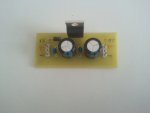I just completed my 08M2 project but only to find out that there are safety issues to be considered in interfacing a Picaxe on a motor vehicle. Basically I would like to in cooperate one of those 9- 24 v DC Motion detectors that would simply serve as a switch to trigger the Picaxe when ever an intruder enters the car.
. My intentions were to use the 12v supply from the car with a suitable fuse for the motion detector, and run the Picaxe off two AAA Bateries and a phone charger connected to the cigarette lighter.
I did some checking on interfacing the project from Post/ threads dating back to 2006 and recently in 2013. There does not seem to be any thing conclusive. However members seem to be confronted with this challenge for quite some time, one of our senior members even sugested it might be better to buy a power supply ( if it can be located ) Thus far is there a simple or rather a workable solution that a non expert can work with.
. My intentions were to use the 12v supply from the car with a suitable fuse for the motion detector, and run the Picaxe off two AAA Bateries and a phone charger connected to the cigarette lighter.
I did some checking on interfacing the project from Post/ threads dating back to 2006 and recently in 2013. There does not seem to be any thing conclusive. However members seem to be confronted with this challenge for quite some time, one of our senior members even sugested it might be better to buy a power supply ( if it can be located ) Thus far is there a simple or rather a workable solution that a non expert can work with.

